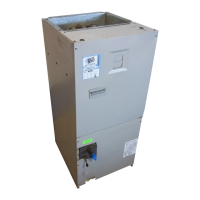12 G6RA, G6RK Service Manual
VENTING REQUIREMENTS
General
This furnace must be vented in compliance with, the current
revision of the National Fuel Gas Code (ANSI-Z223.1/NFPA54),
with the instructions provided below, and with the Category
I Venting Tables provided with the furnace.
In Canada, venting shall conform to the requirements of the
current (CAN/CGA B149.1 or .2) installation codes. Consult
local codes for special requirements.
This furnace must never be vented to a chimney flue
servicing a fireplace or other appliance designed to burn solid
fuel. If the furnace vent is to be connected to a chimney
serving a fireplace, the fireplace must be sealed off from the
chimney.
The furnace vent, if metal, may be insulated if local codes
allow. Any part of the vent system, metal vent only, not
exposed to weather, but which are exposed to ambient
temperatures below 35° F must be insulated to prevent
condensation. All vent insulation shall be foil backed
fiberglass of one inch minimum thickness.
Category I - Common Venting
When an existing furnace is removed from a venting system
serving other appliances, the venting system is likely to be
too large to properly vent the remaining appliances.
The following steps shall be followed with each individual
appliance connected to the venting system placed in operation,
while all other appliances connected to the venting system
are not in operation:
(a) Seal any unused openings in the venting system.
(b) Inspect the venting system for proper size and horizontal
pitch, as required in the National Fuel Gas Code, (ANSI
Z223.1) or the (CAN/CGA B149 ) Installation Codes and
these instructions. Determine that there is no blockage or
restriction, leakage, corrosion or other deficiencies which
could cause an unsafe condition.
(c) In so far as is practical, close all building doors and
windows and all doors between the space in which the
appliance(s) connected to the venting system are located
and other spaces of the building. Turn on clothes dryers and
any appliance not connected to the venting system. Turn on
any exhaust fans, such as range hoods and bathroom
exhausts, so they shall operate at maximum speed. Do not
operate a summer exhaust fan. Close fireplace dampers.
(d) Follow the lighting instructions. Place the appliance being
inspected in operation. Adjust thermostat so appliance shall
operate continuously.
(e) Test for draft hood equipped appliance spillage at the draft
hood relief opening after 5 minutes of main burner operation.
Use the flame of a match or candle.
(f) After it has been determined that each appliance connected
to the venting system properly vents when tested as outlined
above, return doors, windows, exhaust fans, fireplace dampers
and any other gas burning appliance to their previous conditions
of use.
(g) If improper venting is observed during any of the above
tests, the venting system must be corrected.
(Categorie I) — Proceder comme suit pour chaque appareil
raccorde a la tuyauterie d’evacuation et en etat normal de
fonctionnement; tous les autres appareils raccordes a la
meme tuyauterie d’evacuation doivent etre mis hors service:
(a)sceller toute ouverture non utilisee de la tuyauterie
d’evacuation.
(b)s’assurer que la tuyauterie d’evacuation presente des
dimensions et une pente horizontale conformes a la norme
ANSI Z223.1, intitulee National Fuel Gas Code ou aux codes
d’installation CAN/CGA-B149, ainsi qu’aux presentes
instructions. S’assurer que la tuyauterie n’est pas bloquee,
restreinte, corrodee, qu’elle ne fuit pas et qu’elle ne presente
aucun autre defaut potentiellement dangereux.
(c)dans la mesure du possible, fermer toutes les portes et
fenetres du batiment, et toutes les portes entre la piece ou se
trouve l’appareil raccorde a la tuyauterie d’evacuation et les
autres pieces du batiment. Mettre en service les secheuses
et tout autre appareil qui n’est pas raccorde a la tuyauterie
d’evacuation. Faire fonctionner a regime maximal tout
ventilateur d’evacuation, tel que les hottes de cuisiniere et
les ventilateurs de salles de bains. Ne pas mettre en service
les ventilateurs d’ete. Fermer les registres des foyers.
(d)respecter les instructions d’allumage. Mettre en service
l’appareil a l’essai. Regler le thermostat de maniere a ce que
l’appareil fonctionne sans interruption.
(e)s’assurer qu’un appareil muni d’un coupe-tirage ne presente
aucune fuite a l’ouverture du coupe-tirage apres que le bruleur
principal ait fonctionne pendant cinq minutes. Employer la
flamme d’une allumette ou d’une chandelle.
(f)apres avoir determine que tous les appareils raccordes a
la tuyauterie d’evacuation evacuent correctement tel que
prescrit ci-dessus, rouvrir les portes at les fenetres et
remettre les ventilateurs d’evacuation, les registres de foyers
et tout autre appareil fonctionnant au gaz a leur etat de
fonctionnement initial.
(g)si un appareil n’evacue pas correctement a la suite de l’un
des essais ci dessus, corriger la tuyauterie d’evacuation.

